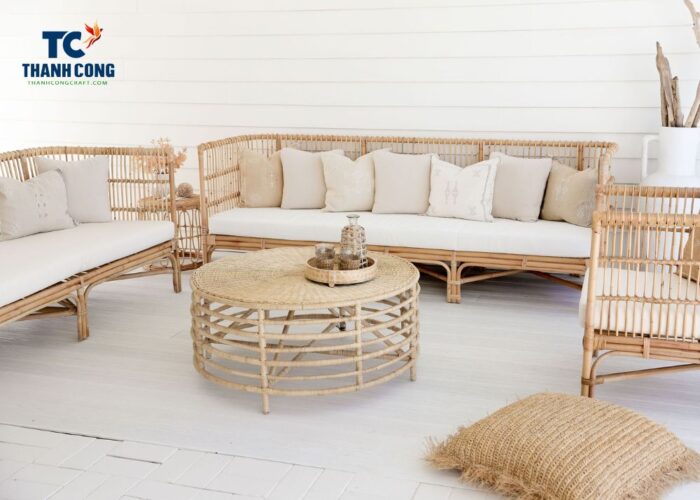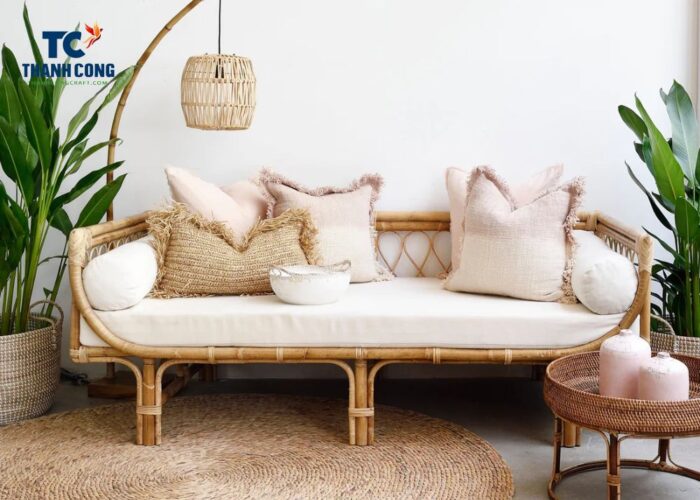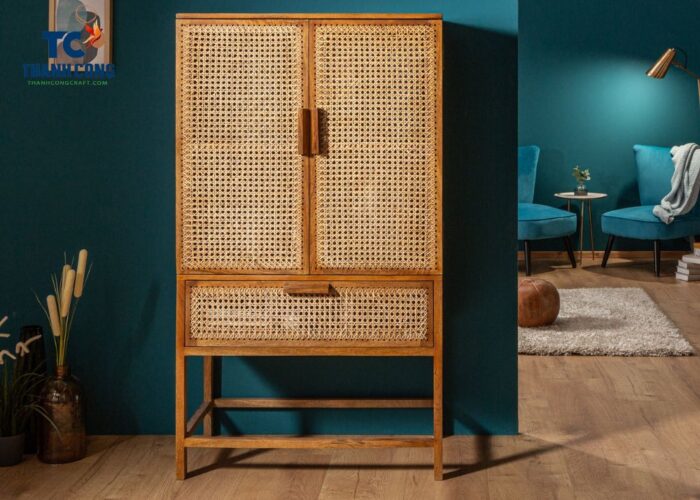Rattan is a type of climbing plant that originates from the tropical regions of Asia and Africa. Rattan can be used to make various products, but the most common one is furniture. How is rattan furniture made? In this article, we will introduce you to the production process of rattan furniture from harvesting to finishing.
Contents
1. How is rattan furniture made?
Rattan is a type of climbing plant that originates from Southeast Asia, Africa and Australia. Rattan can be used to make many types of furniture such as chairs, tables, beds, cabinets and lamps. To make furniture from rattan, one has to go through the following steps:
- Harvesting: Rattan is harvested when the plant reaches the desired size and maturity. The long rattan branches are cut and removed of leaves, thorns and outer bark. This process requires care to ensure that rattan is harvested efficiently without harming the original plant and natural resources.
- Drying: The harvested rattan branches are dried, usually by using a dryer or under sunlight. The goal of this process is to reduce the moisture content in rattan to increase its durability and prevent the formation of mold. It is important that the drying process also helps rattan have a better color and is easy to bend as desired.

- Treatment: The dried rattan branches can be treated by soaking in hot water or chemicals to remove impurities, insects and bacteria. This process also helps rattan have a smooth and glossy surface.
- Bending: The treated rattan branches can be bent into desired shapes by using molds or bending machines. Rattan has the ability to bend easily and can create curved, twisted, circular or other shapes depending on the design of the furniture.
- Rattan Assembly: The bent rattan branches are assembled together by using nails, screws, glue or cords. Details such as cushions, covers, fabrics or leather can be added to increase comfort and luxury for the furniture.
- Finishing: Finally, the product from rattan will be finished by painting, coating or decorating according to customer preferences. The product from rattan can have different colors, styles and designs to suit the living space of each user. This creates flexibility and diversity in choice.
2. How are wicker chairs and rattan furniture made?
Wicker chairs and rattan furniture are products made from tropical plants such as bamboo, rattan, reed, rush, etc. These plants have soft and flexible stems that can be bent and woven into various shapes. The production process of wicker chairs and rattan furniture consists of the following steps.
- Harvesting: The process begins with carefully selecting the suitable bamboo and rattan plants for the product. These plants are harvested and then, all unnecessary parts such as leaves, small branches and small crowns are removed. Before proceeding, the bamboo stems are split into small fibers along the length for use in the production process.
- Drying: After harvesting, the fibers need to be dried. This process needs to be done under controlled temperature and humidity conditions to reduce residual moisture in the fibers and increase their durability. Sometimes, before drying, the fibers are also dyed to create a variety of color options for the final product.

- Weaving and Adjusting: After the fibers have been dried, they will be woven according to the molds that have been designed beforehand. The artisans must have skill to create parts of bamboo chairs and furniture such as frames, legs, backs and other details. This requires patience and high-level technique to ensure that every product has high quality and correct size.
- Finishing: After the parts have been woven, the product will go through the finishing stage. Here, they will be cleaned, painted, or surface treated to increase glossiness and prevent the formation of mold and fungus. In addition, the product can be further decorated with details such as pillows, cushions, fabrics, etc. to create comfort and elegance for the user.
3. Rattan furniture weaving techniques
To craft exquisite rattan furniture pieces, one must pay close attention to the following Rattan furniture weaving techniques:
- Wicker: This is the most difficult technique for the craftsmen. Usually, they weave according to a pattern of over one, under one between the tips and the crowns. This process requires skill and patience, and the final result often brings a subtle and unique beauty.
- Under-and-Over-Weaving: This is the most common and simplest weaving technique. This pattern creates a traditional and simple texture. Although simple, it still attracts the attention of many people because of its classic beauty.
- Double Weaving: This is an effective weaving technique on large surfaces or in strips or patterns of the same or contrasting colors on flat rattan furniture. The double weaving pattern creates a deeper structure for rattan, giving a unique look to the product.

- Pairing Weaving: This weaving technique uses an even or odd number of tips. Each piece of rattan is connected to each other through other tips. This is a weaving technique that creates a relatively complex pattern and is often used to create unique designs.
- Triple Twist Weaving: This weaving technique has a complex process and creates a unique pattern. However, the use of this weaving technique is not as popular as other types of techniques, because not many people have the ability to weave rattan into a three-layer circular pattern.
- Plaiting – Octagonal Plaiting: With eight strands of rattan, the craftsman can create a pattern of hexagonal cells. Four of the strands form a square, and the other four form a diagonal hole. As the weaving progresses, each strand passes over and under the next strand, creating the impression that it has been woven back together.
These weaving techniques not only bring diversity in style and pattern to rattan furniture, but also show the talent and skill of the craftsmen. They highlight the uniqueness and natural beauty of rattan in creating high-quality and beautiful products.
4. FAQs
4.1 Is rattan furniture made by hand or machine?
Rattan furniture can be crafted using both manual labor and machinery, with the choice depending on the specific production process and the desired level of craftsmanship.
Traditional rattan furniture is typically handcrafted by skilled artisans who employ intricate hand weaving techniques to create patterns and designs. Handmade rattan furniture is highly esteemed for its craftsmanship, meticulous attention to detail, and its distinctive, one-of-a-kind quality. Craftsmen meticulously select, prepare, and manually weave rattan, a process that can be time-consuming and labor-intensive.
In contemporary manufacturing, however, machines have found a place in the production of rattan furniture. These machines can automate various weaving and assembly tasks, enhancing production efficiency and reducing costs.
In conclusion, rattan furniture can be manufactured using both manual and automated methods, with the selection often influenced by factors like desired quality, production volume, and cost considerations. Handcrafted rattan furniture is renowned for its artisanal appeal, while machine-produced rattan furniture excels in efficiency and consistency throughout the manufacturing process.
4.2 What is real rattan made of?
Rattan furniture is made from rattan vines which are woven together to create outdoor furniture, which is commonly used in the summer months, rattan can be either natural or synthetic.
Natural rattan, which originates from the fibers of a plant related to palm trees, is not suitable for all kinds of weather and does not last long if exposed to certain conditions. It can be bleached by the sun, which will affect the color. If natural rattan gets soaked by the rain, there’s a risk that the water will be trapped in the weaves, which will lead to mold or mildew.
In conclusion, understanding how rattan furniture is made provides us with insight into the intricate and skilled craftsmanship involved in creating these timeless pieces. Whether crafted by hand by skilled artisans or produced using modern machinery, rattan furniture showcases the versatility and natural beauty of this sustainable material. From harvesting and processing rattan canes to the art of weaving and finishing, each step in the production process contributes to the unique charm and quality of rattan furniture.
If you have a shopping need, don’t hesitate to get in touch with thanhcongcraft via email info@thanhcongcraft.com or WhatsApp: +84967485411. Hope to serve you soon!












